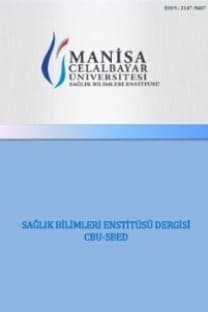Çocuklarda Alt Karın Cerrahisi Sonrası Postoperatif Analjezi için Ultrason Kılavuzluğunda Transversus Abdominis Düzlem Bloğu ile Kaudal Bloğun Karşılaştırılması
Comparison of Ultrasound-Guided Transversus Abdominis Plane Block vs Caudal Block for Postoperative Analgesia After Lower Abdomen Surgery in Children
___
- 1. Long JB, Birmingham PK, et al, Transversus abdominis plane block in children: a multicenter safety analysis of 1994 cases from the PRAN (Pediatric Regional Anesthesia Network) database. Anesthesia and Analgesia, 2014, 119(2), 395-399.
- 2. Wu Y, Liu F, Tang H et al. The analgesic efficacy of subcostal transversus abdominis plane block compared with thoracic epidural analgesia and intravenous opioid analgesia after radical gastrectomy. Anesthesia and Analgesia, 2013, 117, 507–513.
- 3. Abdallah FW, Laffey JG, et al, Duration of analgesic effectiveness after the posterior and lateral transversus abdominis plane block techniques for transverse lower abdominal incisions: a meta-analysis. British Journal of Anaesthesia, 2013,111, 721–735.
- 4. Abdallah FW, Halpern SH, et al, Transversus abdominis plane block for postoperative analgesia after Caesarean delivery performed under spinal anaesthesia? A systematic review and meta-analysis. British Journal of Anaesthesia, 2012, 109, 679–687.
- 5. Sahin L, Sahin M, et al, Ultrasound guided transversus abdominis plane block in children: a randomised comparison with wound infiltration. European Journal of Anaesthesiology, 2013, 30, 409– 414.
- 6. Fredrickson MJ, Paine C, Hamill J. Improved analgesia with the ilioinguinal block compared to the transversus abdominis plane block after pediatric inguinal surgery: a prospective randomized trial. Paediatric Anaesthesia, 2010, 20,1022–1027.
- 7. Visoiu M. Paediatric regional anaesthesia: a current perspective. Current Opinion in Anaesthesiology, 2015, 28(5), 577-582.
- 8. Nanze Yu, Xiao Long, et al, Transversus abdominis-plane block versus local anesthetic wound infiltration in lower abdominal surgery: a systematic review and meta-analysis of randomized controlled trials. BMC Anesthesiology. 2014, 14, 121.
- 9. Sulagna Bhattacharjee, Manjushree Ray, et al, Analgesic efficacy of transversus abdominis plane block in providing effective perioperative analgesia in patients undergoing total abdominal hysterectomy: A randomized controlled trial. Journal of Anaesthesiology Clinical Pharmacology. 2014, 30, 391–396.
- 10. Qingduo Guo, Rui Li, et al, Transversus abdominis plane block versus local anaesthetic wound infiltration for postoperative analgesia: A systematic review and meta-analysis. International Journal of Clinical and Experimental Medicine, 2015, 8, 17343– 17352.
- 11. Bryskin RB, Londergan B, et al, Transversus Abdominis Plane Block Versus Caudal Epidural for Lower Abdominal Surgery in Children: A Double-Blinded Randomized Controlled Trial. Anesth Analg. 2015, 121, 471-478.
- 12. Suresh S, Chan VW. Ultrasound guided transversus abdominis plane block in infants, children and adolescents: a simple procedural guidance for their performance. Paediatric Anaesthesia 2009,19, 296–299.
- 13. Carney J, Finnerty O, et al, Ipsilateral transversus abdominis plane block provides effective analgesia after appendectomy in children: a randomized controlled trial. Anesthesia and Analgesia, 2010,111,998–1003.
- 14. Mai CL, Young MJ, Quraishi SA. Clinical implications of the transversus abdominis plane block in pediatric anesthesia. Paediatric Anaesthesia, 2012, 22, 831–840.
- 15. McDonnell JG, Curley G, Carney J et al. The analgesic efficacy of transversus abdominis plane block after cesarean delivery: a randomized controlled trial. Anesthesia and Analgesia, 2008, 106,186–191.
- 16. Warner MA, Kunkel SE, et al, The effects of age, epinephrine, and operative site on duration of caudal analgesia in pediatric patients. Anesthesia and Analgesia, 1987, 66, 995–998.
- 17. Ansermino M, Basu R, et al, Nonopioid additives to local anaesthetics for caudal blockade in children: a systematic review. Paediatric Anaesthesia 2003, 13,561–573.
- ISSN: 2147-9607
- Yayın Aralığı: Yılda 4 Sayı
- Başlangıç: 2014
- Yayıncı: Manisa Celal Bayar Üniversitesi Sağlık Bilimleri Enstitüsü
Şadiye GÜNPINAR, Olgu ALPERAT KILIÇ, Mehmet TOSUN, Tülin FIRAT
Eralp ÇEVİKKALP, Gülay OK, Koray ERBÜYÜN, Demet AYDIN, İdil TEKİN
Sezaryen Sonrası Benlik Saygısı ve Vücut Algısı
Aylin AYDIN SAYILAN, Ezgi SEYHAN AK, Ezginur İNAN, Ayşe KAVASOĞLU
Süperior Pediküllü Retroauriküler Flep ile Kulak Sayvanı Defektlerinin Onarımı
Yüksek Riskli Gebelerde Anksiyete ve Depresyon ile Hemşirelik Bakım Memnuniyetinin İncelenmesi
Duygu GÜLEÇ, Ayse EMİNOV, Oya KAVLAK
Gebelikte Tromboemboli ve Antikoagülan Kullanımında Ebelik Yaklaşımı
Ünzüle SERİN, Nuran AYDIN ATEŞ, Asiye AYAR KOCATÜRK
Şizofreni Hastalarının Bakım Verenlerinde İfade Edilen Duygu ve Mizaç Özellikleri Arasındaki İlişki
Bilge DOĞAN, Çağdaş Öykü MEMİŞ, Müge BULUT, Yaşan Bilge ŞAİR, Levent SEVİNÇOK
SÜPERİOR PEDİKÜLLÜ RETROAURİKÜLER FLEP İLE KULAK SAYVANI DEFEKTLERİNİN ONARIMI
Yavuz KEÇECİ, Zülfükar Ulaş BALİ
Şizofreni hastalarının bakım verenlerinde duygu dışa vurum ve mizaç özellikleri ilişkisi
Çağdaş Öykü MEMİŞ, Bilge DOĞAN, Müge BULUT, Yaşan Bilge ŞAİR, Levent SEVİNÇOK
Manisa’da 5-14 Yaş Arası Çocuklarda Enürezis Nokturna Sıklığı ve İlişkili Faktörler
